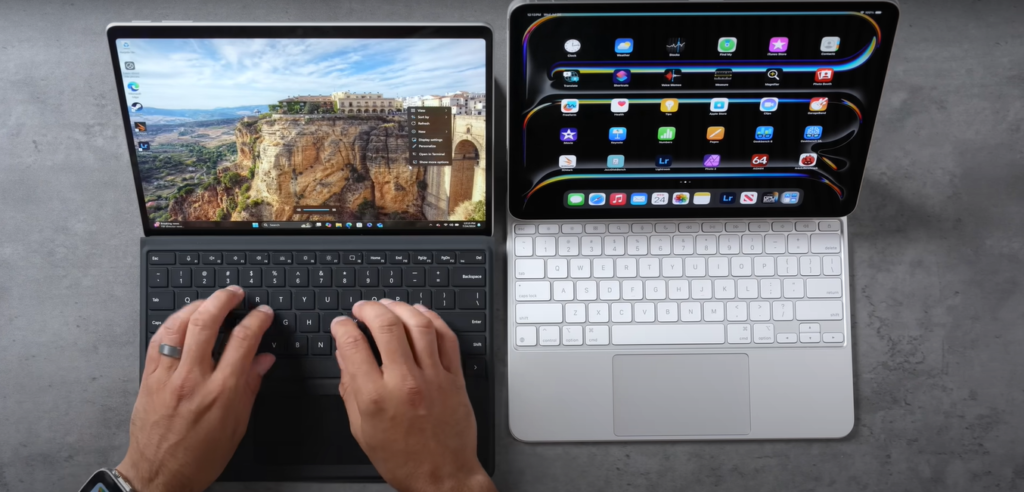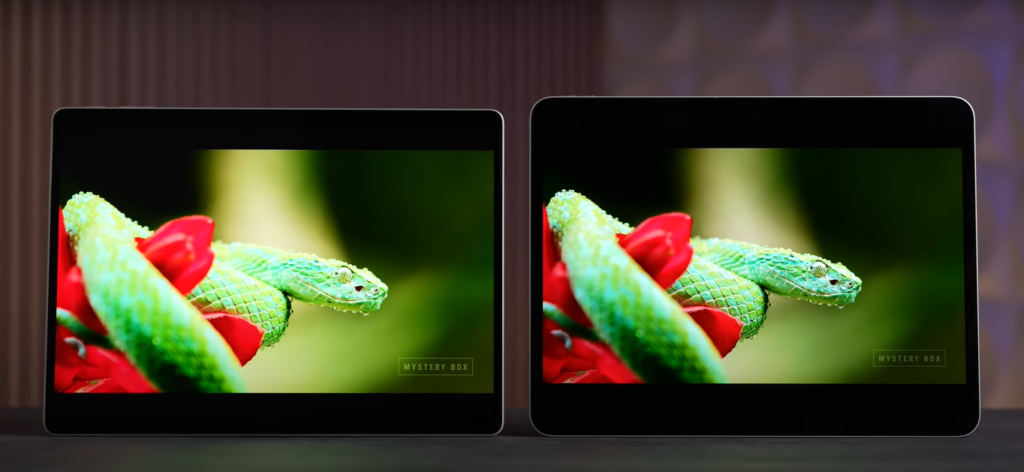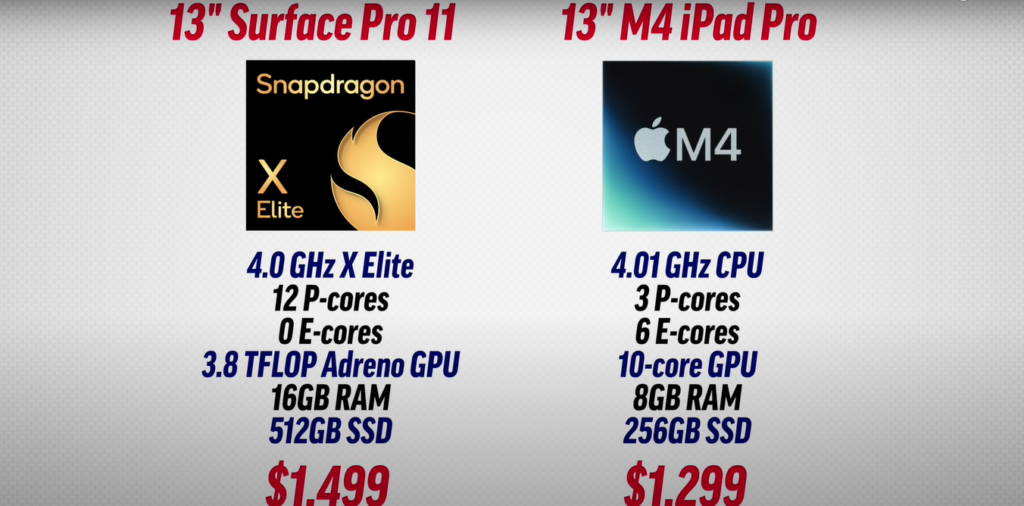Surface Pro 11 vs. M4 iPad Pro: The REAL Pro Tablet?
The release of the Surface Pro 11 and the M4 iPad Pro has intensified the competition in the realm of high-performance tablets. Both devices claim to offer the ultimate blend of portability, performance, and professional features, but which one truly deserves the “Pro” title? In this comprehensive comparison, we will delve into every aspect of these powerhouse tablets, from design and build quality to performance and software capabilities. Whether you’re a creative professional, a student, or a business user, this review will help you decide which tablet best suits your needs.

Design and Build Quality
Surface Pro 11:
- Build: The Surface Pro 11 boasts a robust design with a built-in kickstand that offers great flexibility. Its aluminum cover feels premium and durable, giving it a professional aesthetic.
- Keyboard: The keyboard attaches magnetically and provides a natural typing angle. It’s less expensive but also more flimsy compared to the iPad’s Magic Keyboard. The “diving board” design of the trackpad is functional but not as refined.
- Thickness and Weight: Due to its integrated stand and SSD, the Surface Pro 11 is nearly twice as thick as the iPad Pro. This makes it heavier and less comfortable for prolonged handheld use.
- Portability: Despite its bulkier build, the Surface Pro 11’s kickstand allows for various viewing angles, enhancing its usability in different scenarios.

M4 iPad Pro:
- Build: The iPad Pro features an incredibly thin and lightweight design. Its floating Magic Keyboard provides an elegant typing experience with a solid aluminum cover and a magnetic trackpad that feels premium and responsive.
- Keyboard: The Magic Keyboard offers a superior typing experience with a sturdy build and better portability when detached from the iPad. The floating design adds to its sleek look and functional appeal.
- Thickness and Weight: The iPad Pro is significantly thinner and lighter than the Surface Pro 11, making it more comfortable for handheld use and extremely portable.
- Portability: Its sleek design and lightweight build make the iPad Pro extremely portable, ideal for on-the-go use. The need for a large piece to support it at an angle can be a drawback compared to the Surface Pro’s versatile kickstand.
Display and Audio Quality
Surface Pro 11:
- Display: The Surface Pro 11 features a high-quality OLED display that delivers vibrant colors and good brightness. It’s not as bright as the iPad Pro’s display but still offers an excellent viewing experience.
- Brightness: Rated at 900 nits, the Surface Pro’s display is impressive for HDR content but falls short of the iPad Pro’s 1600 nits.
- Reflectivity: The Surface Pro’s display is quite reflective, which can be a drawback in bright environments. This could be a significant factor for users who often work in well-lit or outdoor settings.
- Audio: The Surface Pro 11 has front-facing speakers that deliver good sound quality, though not as impressive as the iPad Pro’s speakers. They are louder than expected with decent bass, but the iPad Pro’s audio is superior.

M4 iPad Pro:
- Display: The iPad Pro’s display is a standout feature, offering superior brightness, contrast, and anti-reflective coatings. It’s designed to handle HDR content beautifully, making it ideal for media consumption and creative work.
- Brightness: With a peak brightness of 1600 nits, the iPad Pro’s display is ideal for HDR content and outdoor use. This makes it more versatile for various lighting conditions.
- Reflectivity: The iPad Pro’s anti-reflective coating significantly reduces glare, making it more suitable for bright environments and outdoor use.
- Audio: The iPad Pro delivers exceptional audio quality from its thin chassis, with superior sound clarity and depth compared to the Surface Pro 11. It’s impressive how Apple managed to achieve such high-quality sound in a slim device.
Performance and Hardware
Surface Pro 11:
- Processor: Equipped with the X Elite processor featuring 12 performance cores, the Surface Pro 11 delivers outstanding multi-core performance. This makes it a powerhouse for demanding applications and multitasking.
- Benchmark Scores: In multi-core tests, the Surface Pro 11 scores 14,689, surpassing the iPad Pro’s capabilities. However, in single-core performance, it falls short with a score of 2853.
- Thermals and Cooling: The Surface Pro 11 includes fan cooling, allowing it to maintain performance under heavy loads without significant thermal throttling. This is a critical feature for intensive tasks.
- Storage and Ports: The Surface Pro 11 offers two USB-C ports with ultra-fast speeds (40 Gbps), a magnetic charging connector, and user-swappable SSDs, providing more versatility and expandability. These features are a significant advantage for professional users who need flexible connectivity and storage options.

M4 iPad Pro:
- Processor: The M4 chip in the iPad Pro is a powerhouse, excelling in single-core performance with unmatched efficiency. This makes it incredibly responsive for most tasks, especially those optimized for iPadOS.
- Benchmark Scores: The iPad Pro’s single-core performance is unparalleled, but it lags behind the Surface Pro 11 in multi-core tasks. This is evident in tasks that require extensive multitasking or heavy computational power.
- Thermals and Cooling: The iPad Pro operates without a fan, relying on efficient passive cooling, which keeps it silent but may limit performance under sustained heavy loads.
- Storage and Ports: The iPad Pro includes a single USB-C port on the device and one on the Magic Keyboard for charging, limiting its connectivity options compared to the Surface Pro 11. This could be a limiting factor for users needing multiple peripheral connections.
Software and Usability
Surface Pro 11:
- Operating System: Running a full version of Windows, the Surface Pro 11 offers the versatility of a desktop operating system in a portable form factor. This allows users to run professional software like Adobe Premiere Pro, Lightroom Classic, and full versions of Microsoft Office.
- Software Compatibility: The ability to run a wide range of professional and legacy applications makes the Surface Pro 11 a more versatile tool for professionals. This is crucial for users who rely on specific software that isn’t available on iPadOS.
- Productivity: With the flexibility of Windows, users can easily switch between tablet and desktop modes, use multiple windows, and manage files more efficiently. This enhances productivity for users who need a robust multitasking environment.
M4 iPad Pro:
- Operating System: The iPad Pro runs iPadOS, which is optimized for touch and Apple Pencil use. While it offers a smooth and intuitive user experience, it lacks the flexibility of a desktop OS.
- Software Compatibility: iPadOS supports a growing number of professional apps, but it still falls short compared to Windows in terms of software availability and functionality. Creative professionals might find it limiting if their preferred tools are not available.
- Productivity: While the iPad Pro is excellent for creative tasks like drawing and photo editing, its multitasking capabilities and file management are limited compared to Windows, which can be frustrating for power users. The reliance on touch and the constraints of iPadOS can hinder productivity in more complex workflows.
Battery Life and Efficiency
Surface Pro 11:
- Battery Life: The Surface Pro 11 offers decent battery life, significantly improved from previous Intel models. However, it still consumes more power than the iPad Pro, especially under heavy workloads.
- Power Efficiency: Running Windows and powerful hardware means higher power consumption, but the Surface Pro 11 manages to maintain good battery life for most tasks.
- Usage Scenarios: Best used with the kickstand and keyboard for a laptop-like experience, the Surface Pro 11 is less suited for prolonged handheld use due to its weight and bulk.
M4 iPad Pro:
- Battery Life: The iPad Pro excels in battery efficiency, lasting significantly longer on a single charge compared to the Surface Pro 11.
- Power Efficiency: The M4 chip and iPadOS are optimized for efficiency, providing excellent battery life even with demanding applications.
- Usage Scenarios: Ideal for handheld use, the iPad Pro’s lightweight design and long battery life make it perfect for mobile use, creative work, and media consumption.
Cameras and Connectivity
Surface Pro 11:
- Front Camera: The Surface Pro 11 features a 1440p front camera with wide-angle capabilities, making it suitable for video conferencing and content creation.
- Microphones: Dual front-facing microphones provide clear audio capture for calls and recordings.
- Connectivity: With more ports, including two USB-C ports and a magnetic charging connector, the Surface Pro 11 offers better connectivity options than the iPad Pro. This is a significant advantage for users who need multiple peripheral connections and faster data transfer.
M4 iPad Pro:
- Front Camera: The iPad Pro has a 1080p front camera with wide and cropped modes, offering flexibility for different use cases.
- Microphones: The iPad Pro’s microphones deliver high-quality audio, but they don’t match the clarity of the Surface Pro 11’s setup.
- Connectivity: Limited to a single USB-C port and one additional port on the Magic Keyboard for charging, the iPad Pro’s connectivity options are more restricted. This could be a drawback for users who need to connect multiple devices simultaneously.
User Experience and Ecosystem
Surface Pro 11:
- User Experience: With a full Windows operating system, the Surface Pro 11 offers a familiar and flexible user experience, ideal for those accustomed to desktop environments.
- Ecosystem: The Surface Pro 11 integrates seamlessly with other Windows devices and services, making it a great choice for users invested in the Microsoft ecosystem.
- Professional Use: Ideal for professional users who need a versatile device capable of running full desktop applications and handling complex workflows.
M4 iPad Pro:
- User Experience: The iPad Pro offers a smooth and intuitive user experience with iPadOS, optimized for touch and Apple Pencil use.
- Ecosystem: Perfect for users deeply integrated into the Apple ecosystem, the iPad Pro works seamlessly with other Apple devices and services.
- Creative Use: Best suited for creative professionals who value the high-quality display, excellent performance, and portability for tasks like drawing, photo editing, and video playback.
Key Takeaways and Recommendations
After a detailed comparison, it’s clear that both the Surface Pro 11 and the M4 iPad Pro have their strengths and weaknesses. Your choice will largely depend on your specific needs and how you plan to use the device.
Surface Pro 11:
- Strengths:
- Full Windows OS for professional software compatibility
- Versatile kickstand and swappable SSD
- Better connectivity options with multiple ports
- Impressive multi-core performance
- Weaknesses:
- Thicker and heavier, less comfortable for handheld use
- Reflective display, less suitable for bright environments
- Shorter battery life compared to iPad Pro
- Ideal For: Professionals who need a robust device capable of running full desktop applications, those who require extensive multitasking, and users who need versatile connectivity and expandability.
M4 iPad Pro:
- Strengths:
- Superior display with higher brightness and anti-reflective coating
- Lightweight and portable design
- Exceptional single-core performance and battery efficiency
- Seamless integration with the Apple ecosystem
- Weaknesses:
- Limited by iPadOS in terms of software compatibility and multitasking
- Fewer connectivity options with only one USB-C port
- Less suitable for tasks that require a full desktop operating system
- Ideal For: Creative professionals who value the high-quality display, excellent performance, and portability, those who are deeply integrated into the Apple ecosystem, and users who prioritize battery life and on-the-go use.
Conclusion: Which One is Best?
Choosing between the Surface Pro 11 and the M4 iPad Pro ultimately comes down to your specific needs and preferences.
- If you need a device that functions as a full-fledged laptop replacement, capable of running a wide range of professional software, offering versatile connectivity, and handling complex workflows, the Surface Pro 11 is the better choice. Its robust Windows OS, impressive multi-core performance, and versatile kickstand make it a powerful tool for productivity.
- If you prioritize a sleek, lightweight design, superior display quality, and seamless integration with other Apple devices, the M4 iPad Pro is the way to go. Its exceptional single-core performance, battery efficiency, and optimized iPadOS make it an excellent choice for creative professionals and users who need a highly portable device for on-the-go use.
In the end, both tablets are excellent in their own right, and your decision should be guided by what features and capabilities matter most to you.

